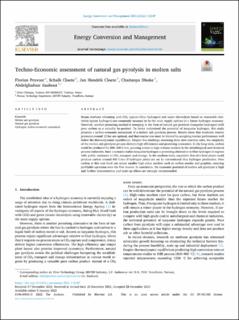| dc.contributor.author | Pruvost, Florian | |
| dc.contributor.author | Cloete, Schalk Willem Petrus | |
| dc.contributor.author | Cloete, Jan Hendrik | |
| dc.contributor.author | Zaabout, Abdelghafour | |
| dc.date.accessioned | 2022-06-17T10:09:49Z | |
| dc.date.available | 2022-06-17T10:09:49Z | |
| dc.date.created | 2022-01-12T06:16:46Z | |
| dc.date.issued | 2022 | |
| dc.identifier.citation | Energy Conversion and Management. 2022, 253, 1-11. | en_US |
| dc.identifier.issn | 0196-8904 | |
| dc.identifier.uri | https://hdl.handle.net/11250/2999272 | |
| dc.description.abstract | Steam methane reforming with CO2 capture (blue hydrogen) and water electrolysis based on renewable electricity (green hydrogen) are commonly assumed to be the main supply options in a future hydrogen economy. However, another promising method is emerging in the form of natural gas pyrolysis (turquoise hydrogen) with pure carbon as a valuable by-product. To better understand the potential of turquoise hydrogen, this study presents a techno-economic assessment of a molten salt pyrolysis process. Results show that moderate reactor pressures around 12 bar are optimal, and that reactor size must be limited by accepting reactor performance well below the thermodynamic equilibrium. Despite this challenge stemming from slow reaction rates, the simplicity of the molten salt pyrolysis process delivers high efficiencies and promising economics. In the long-term, carbon could be produced for 200–300 €/ton, granting access to high-volume markets in the metallurgical and chemical process industries. Such a scenario makes turquoise hydrogen a promising alternative to blue hydrogen in regions with public resistance to CO2 transport and storage. In the medium-term, expensive first-of-a-kind plants could produce carbon around 400 €/ton if hydrogen prices are set by conventional blue hydrogen production. Pure carbon at this cost level can access smaller high-value markets such as carbon anodes and graphite, ensuring profitable operation even for first movers. In conclusion, the economic potential of molten salt pyrolysis is high and further demonstration and scale-up efforts are strongly recommended. | en_US |
| dc.language.iso | eng | en_US |
| dc.publisher | Elsevier | en_US |
| dc.rights | Navngivelse 4.0 Internasjonal | * |
| dc.rights.uri | http://creativecommons.org/licenses/by/4.0/deed.no | * |
| dc.subject | techno-economic assessment | en_US |
| dc.subject | Hydrogen | en_US |
| dc.subject | Natural gas pyrolysis | en_US |
| dc.subject | Molten salt pyrolysis | en_US |
| dc.title | Techno-Economic assessment of natural gas pyrolysis in molten salts | en_US |
| dc.title.alternative | Techno-Economic assessment of natural gas pyrolysis in molten salts | en_US |
| dc.type | Peer reviewed | en_US |
| dc.type | Journal article | en_US |
| dc.description.version | publishedVersion | en_US |
| dc.rights.holder | © 2022 The Authors. Published by Elsevier Ltd | en_US |
| dc.source.pagenumber | 10 | en_US |
| dc.source.volume | 253 | en_US |
| dc.source.journal | Energy Conversion and Management | en_US |
| dc.identifier.doi | 10.1016/j.enconman.2021.115187 | |
| dc.identifier.cristin | 1978961 | |
| dc.source.articlenumber | 115187 | en_US |
| cristin.ispublished | true | |
| cristin.fulltext | original | |
| cristin.qualitycode | 1 | |

